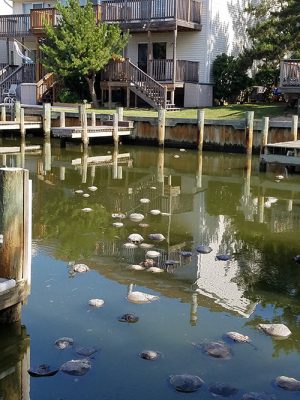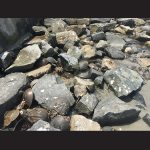
OCEAN CITY — Mary Jo Pollock was walking her dog late last week in her neighborhood in mid-town Ocean City when she smelled an odor that was incredibly pungent.
“The air smelled so fishy,” said Pollock, “so I looked in the canal and there were dozens and dozens of these things floating in the water that looked like big brown balls.”
Those balls, were dead horseshoe crabs.
The Maryland Coastal Bays Program says a significant number of dead horseshoe crabs washed into a canal on 94th Street and alarmed many residents, but on the whole, there is nothing “fishy” going on, despite the smell.
This is spawning season for the ancient horseshoe crab, which is older than 99% of all species on the planet. During spawning, up to 10% of the population can die because the act of spawning is incredibly stressful to older horseshoe crabs. Since spawning occurs during full and new moon cycles, horseshoe crabs often get caught up in the tides and swept against sand bars or rip-rap, which can also cause death.
The tide cycles, and in some cases, wind can play a factor in transporting large numbers of dead horseshoe crabs into local canals or waterways, according to the Maryland Coastal Bays Program (MCBP).
Yet, while this event on 94th Street could largely be a natural, “circle-of-life” type incident, Maryland Natural Resource Biologist Steve Doctor says other factors could be at play as well.
 “There may have been additional stress on the horseshoe crabs from large deficits of dissolved oxygen (DO) attributed to a huge bloom of macroalgae in the Assawoman Bay earlier in the year,” he said in a statement. “Low DO is when oxygen levels in the water are too low to support life. The low DO may be attributed to a huge bloom of macroalgae that recently died and decayed in Assawoman Bay.”
“There may have been additional stress on the horseshoe crabs from large deficits of dissolved oxygen (DO) attributed to a huge bloom of macroalgae in the Assawoman Bay earlier in the year,” he said in a statement. “Low DO is when oxygen levels in the water are too low to support life. The low DO may be attributed to a huge bloom of macroalgae that recently died and decayed in Assawoman Bay.”
Doctor says factors leading to this possible conclusion were carapaces (molts) of horseshoe crabs too young to spawn along with the adults as well as carapaces of blue crabs.
Bruce Michale, who is the Maryland DNR Director of Resource Assessment Service, agrees.
“Water quality data from Assawoman tributaries is indicating relatively low DO reading — less than 2.0 mg/l,” he said. “DO can go lower (hypoxic/anoxic) in some of these dead end canals, so low DO could have contributed to this mortality event.”
However, Doctor says despite the algae bloom’s impact on water quality, the ecosystem in which these ancient animals exist in seems fine. “The good news is fish and crabs are recolonizing, the macro-algae is less and overall the crab population is healthy,” he said.
Back in the neighborhood, Pollock has been wondering who is responsible for removing all these dead horseshoe crabs.
The MCBP says there is currently not an agency responsible for cleaning up dead horseshoe crabs during spawning season, but a local volunteer, Michael Baier, coordinated a number of local volunteers to clean up the hundreds of dead horseshoe crabs that had drifted into local canals.
Ocean City Environmental Engineer Gail Blazer coordinated with Ocean City Public Works Director Hal Adkins to dispose of the carcasses.
